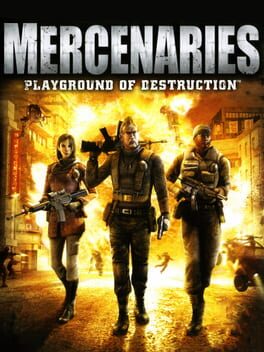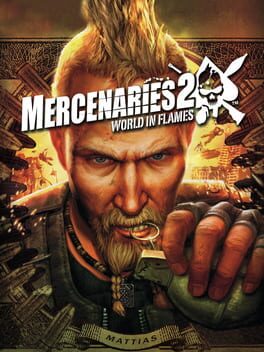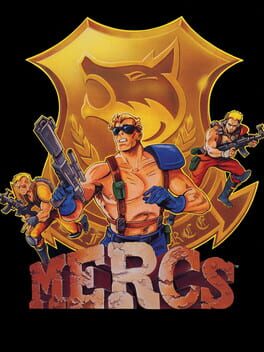

During the last years of his reign, the North Korean president Choi Kim attempted a reconciliation with the country's southern neighbor, with the ultimate goal of reunification. However, his son, General Choi Song, and the military clique under his leadership, strongly disagreed with the old man's views. Eventually, Choi Song orchestrated his own father's assassination, took control of North Korea, and severed ties with the outside world. Eventually, plans of a nuclear reactor construction began to surface. China, South Korea, the Allied Nations and even the Russian Mafia sent troops to North Korea, competing for power in the troubled region. A bounty of a hundred million dollars for General Song was declared. This is where the mercenaries enter the playfield. Mercenaries: Playground of Destruction is a free-roaming war action and driving game with open-ended gameplay in a large world. The player can choose to control any of the three mercenary protagonists, each with their own strengths: North American Chris Jacobs can sustain higher damage; Jennifer Mui from Hong-Kong is proficient in stealth; Mattias Nilsson from Sweden can run faster than the others. Each of the mercenary also speaks different languages, which makes him or her more or less suitable for work with particular factions. Players have free reign of a massive landscape to take bounties on the "Deck of 52", a list of most wanted criminals in North Korea, as well as a number of factions. Four factions have moved in to take advantage of the coup for personal gains; each faction will offer the player resources such as vehicles and supplies, as well as missions that the player can use to make money off of. If the player makes a faction happy, they will offer intel on the locations of various bounties from the deck. Players have a vast array of resources available to them to get the job done. It is possible to commandeer tanks, choppers and and any other military hardware to blow up the game's destructible landscape across the North Korean countryside. Helping out various factions provides access to numerous vehicle drops, supply drops, and air strikes.
Also in series
Reviews View More
However, the part nobody wants to talk about is how obscenely dull the game is otherwise. Missions are the most boring "go here, plant C4, defend this point" slop imaginable, to the point where they almost feel like they were procedurally generated. Side activities are populated almost entirely by checkpoint "races." Environments are shockingly barren, gunplay feels bad, and it features the most insane crosshair placement I've seen in any game that doesn't have "Halo" in its title. This game feels like it was made by aliens. The dialogue is unnatural and the controls are completely batshit (you also drive vehicles by pressing A to accelerate and X to brake).
The thing is, you could look at all of this stuff, and how it's an original Xbox/PS2 game, and think, "oh, it's just a very early open world game."
This came out in 2005.
TWO THOUSAND AND FIVE. The same year Splinter Cell: Chaos Theory came out. Riddick: Escape from Butcher Bay had been out for a year. For more apples-to-apples comparisons, Hulk: Ultimate Destruction also released in 2005, and GTA San Andreas had come out a few months earlier. The Xbox 360 would arrive in November of 2005. This is just straight-up embarrassing.
Mercenaries did have one interesting concept, with the "Deck of 52" system. There were 52 enemies that were "high value targets" and could be captured to get extra money. It was sort of the precursor to the Nemesis system from the Mordor games, in a way, but most of them don't really stand out, and they're essentially just another collectible.
The legacy of Mercenaries, or at least the idealized version of what it represented, would thankfully be carried on by the Just Cause series, the worst entry in which is still far more fun to play than this. There was a Mercenaries 2, released in 2008, and I remember liking it. It was completely busted, and got a lot of flack for that, but I still remember it being much more enjoyable than the first game's utter slog.
3/10
thank you phil spencor for letting me play this shit game in 4k resolution on my x box series x you are a great man dedicated gtoo game presvertaion and i like thatyou wor e a bttletoads shirtgbnnnnn
Don’t have anything too cohesive to say, so an assortment of stray thoughts:
- Continually appreciated that air-lifting targets is an on-demand invitation for chaos: Simply killing and verifying anyone in the Deck of 52 isn’t much trouble, but the process of going for a non-lethal takedown, of finding a safe area to call in a helicopter, and then extracting the HVT is consistently tense. The chopper can get shot down, enemies can commandeer your vehicle, and there’s the chance that the target will still get killed in the process. Easily one of the best “moments” generators in the entire game.
- Stick with the Russian Mafia missions when possible, there's definite sense that they were authored with a better understanding of the systems at play. Where the other factions send you on generic missions to destroy X number of targets with few complications, the Mob will have you assassinating high-value targets from other factions and dealing with their internal politics, and is far better about throwing curveballs in with its secondary objectives. If the rest of the game was on this level, it’d be far easier to praise it as an underrated classic- the one set of missions that lives up to the title by asking you to do questionable things under unreasonable conditions.
- I played a ton of Mercenaries 2 as a kid and the ability to destroy buildings was a huge draw for me, so it was a little weird playing this, where so much of the action takes place on barren mountain sides and next to humble, single-story structures. The ability to destroy buildings is still appreciated, but lacks a lot of the raw catharsis you’d expect from something framed as a centerpiece mechanic- ends up being more of a tactile flourish in practice.
- Admire the general structural flexibility here as well, as once you complete the initial circuit of missions to get acquainted with the factions, you’re free to work your way to each of the four “Ace” contracts by either taking on missions with the various organizations to get more intel or just combing over the map to get at the scattered members of the Deck of 52. Your approach will inevitably be a combination of the two, but it’s cool to have the freedom to not engage with certain factions or have to be obliged to extract every single member in a suit.
- Forgot there was a time when an open-world was divided up into multiple zones instead of being a single gargantuan one. The game is split into two maps, the first of which ends up being a real pain to navigate, with lots of dead-ends and a lack of easy access to helicopters making your trips between the various HQ’s feel like genuine commutes. Second map is a lot better to navigate, thanks to some more thoughtful road design, but there’s still stretches where your eyes are going to glaze over as you get from A to B. (and in the process, is a great reminder at how load-bearing the radio stations are in the GTA games)
- As with so many game economies, eventually reached a point where money stopped mattering, functionally being able to call in whatever I’d need for a particular mission, and more than enough to bribe officials to get back into the graces of a given faction. Still nice as something to latch onto as a metric for your success, but it’s an element that could’ve been greatly expanded on, with more expenditures to sap from your war chest and less support from your allies- the gear they supply you with at the beginning of missions feeling especially unnecessary given that so many objectives can be beaten with some salvaged explosives and a commandeered tank.
Still, better than most other open-world titles: equal parts a pleasantly-boring podcast game and a genuinely great sandbox, and a reminder that, with a playthrough took a little under ten hours, this genre doesn't have to be a life-consuming timesink. Ended up being weirdly compelled by it, and I’m still tempted to go back- while the different factions and character choices aren’t drastically different from each other, they speak to a better understanding of the chaos and player freedom that should be the main draw of this style of game.



